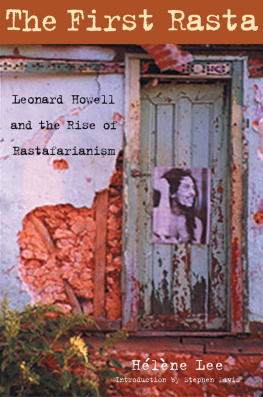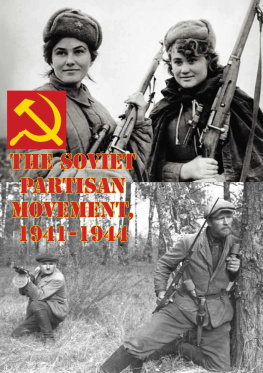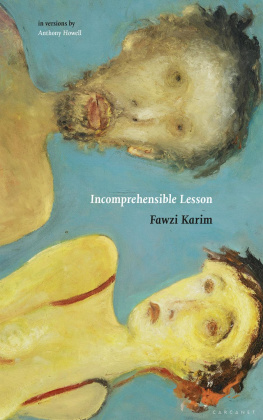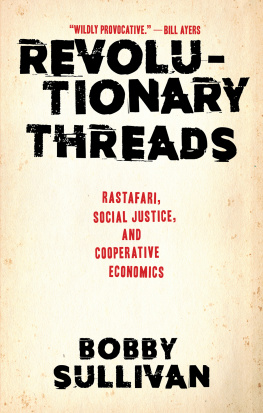
Library of Congress Cataloging-in-Publication Data
Lee, Hlne.
[Premier Rasta. English]
The first Rasta : Leonard Howell and the rise of Rastafarianism / by Hlne Lee ; translated by Lily Davis and Hlne Lee ; edited and with an introduction by Stephen Davis.
p. cm.
Includes bibliographical references and index.
ISBN 1-55652-466-8
1. Maragh, G. G. 2. Rastafari movementHistory.
I. Davis, Stephen, 1947 II. Title.
BL2532.R37 L44513 2003
299.676dc21
2002153774
Jacket design: Joan Sommers Design
Jacket photograph: Susanne Moss/Selah Photo
Interior design: Pamela Jurez
Originally published in 1999 by Flammarion, France, as Le Premier Rasta
Copyright Flammarion, 1999
This translation copyright 2003 by Lawrence Hill Books
An imprint of Chicago Review Press, Incorporated
All rights reserved
First English language edition
Published by Chicago Review Press, Incorporated
814 North Franklin Street
Chicago, Illinois 60610
ISBN 1-55652-466-8
Printed in the United States of America
5 4 3 2 1
Contents
by Stephen Davis
(Interview with Blade Howell)
Give Thanks
To Prof. Robert Hill, with respect. To Donovan Philips, who could have written this book. To the Brethren who accepted and encouraged me, and patiently answered my questions: Mortimer Planno, Bongo Puru, Bongo Sheffan, The Mystic Revelation of Rastafari, Jah Youth, Johnny Dizzy Moore, Bro Manny, Bro Sam, David Elliott, Bernard Satta Collins, Cedric Im Brooks, and all the others. Jah Love! To the elders of Tredegar Park: Miss Amy, Miss Vinette, Chi-chi Boy, and the queenMiss Gertrude Campbell. To Jimmy Cliff. To Ras Miguel Lorne for his work on the diffusion of Rasta thought. To the Jamaica Institute, the National Archives of Jamaica in Spanish Town, the Schomburg Center in New York, the University of the West Indies, and to Profs. Ajai and Laxmi Mansingh, Prof. Barry Chevannes, and Mrs. Dunn. To Sister Ignatius, Joe Watt, Hartley Neita, Dicky Jobson, Winston Chang, and Miss Lucy Lovelace. To Sharon and Gladdy, for their patience. To Perry, Sally, and Jasonguardian angels, without whom To David Marchand, spiritual artist. To Stephen Davis and Lily Davis. To Francis Falceto. To Bruno Bayon who had the idea for this book, and to Bernard Loupias who belived it. To Yuval Taylor and Lawrence Hill Books. To my lovely and brave daughter Melanie (Sometimes I wish I had a mother like all the others) and everyone who supported me. To the entire Howell family: Avinel Taylor, Patrick, Son and Lesford, Daphney, Kathleen, Curlyn, Rosie, and their children. Special thanks to Monty and Blade.
Fools saying in their hearts, Rasta, your god is dead. But I and I know Jah live!
Bob Marley

Leonard Howell.
Introduction
When Bob Marley began his reggae crusade in 1972, he came armed not just with the best street poets songbook since Bob Dylan, but with a strange new spiritual nationality as well. The first time I interviewed Bob, in Boston the following year, he was much more interested in talking about being a Rastafarian than he was about selling reggae music, which was beginning to catch fire with its own irresistible momentum. Sitting in a Beacon Street motel room amid lounging members of his band and the aroma of cooking vegetables, Marley quietly said that he and the band thought that the Ethiopian emperor, Haile Selassie I, was a living god. Taking off his wool cap and shaking out his dreadlocks, the twenty-eight-year-old singer looked me in the eye and quoted the lyric he and Peter Tosh were singing every night to ecstatic audiences in small clubs around America: We know and we over-stand, Almighty God is a living man.
Not many of the rock stars I wrote about for Rolling Stone in the 1970s arrived with such unshakeable belief in a spiritual manifesto. And it wasnt just the Wailers. Most of the hot new reggae stars emerging from JamaicaBurning Spear, Big Youth, Max Romeo, the Heptonesalso wore flamboyant, ropy dreadlocks and sported the signifying red, green, and gold colors of the Rastas. All were careful to warn against the assumption that Rasta was just a fad or a hairstyle. The worst that could be said about such a person was Him have locks on him head, but not in him heart.
As Marleys fame spread through the Wailers early albums and their incandescent performances, journalists literally lined up to speak with Bob. His record company imported them to Kingston in packs. Reggae and the cultural shock wave pulsing outward from Jamaica was the best story most of them had ever seen. For the next three years, Bob Marley fenced with his many interviewers about his deeply held faith. Yes, he told them, Haile Selassie was Jah, Rastafari, who liveth and reigneth I-tinually. Marley spoke and sang in a Rasta jargon that was quick to catch on, and his words were punctuated with jabs of a burning marijuana spliff the size of a cigar. Reggaes popularity grew even faster when music fans on both sides of the Atlantic were made to understand that marijuanacalled ganja in Jamaicawas a sacrament to the Rastas.
Many of the journalists sent to interview Bob were openly skeptical about the divinity of the emperor, especially after Selassie was overthrown in a 1974 coup amid terrible famine and civil war in Ethiopia. Bob Marley remained adamant in his faith. Few of the writers who argued with him realized that Bob was on a personal crusade, and indeed had been dispatched on a dangerous international mission by important Rasta elders in Jamaica, who assured him that his ambitious pursuit of planetary renown was part of the plan to spread the word that a Black King had come to redeem the world, if only the world could be made to take heed.
When I next spent time with Bob Marley, at his house in Kingston in 1976, he was obviously tiring of the repetitive rigors of marketing Rasta to the world, but his belief in the power of Jah was no less diminished. He was performing his intense anthems and modern psalms in front of huge cloth backdrops depicting Selassie in his glory, and recording new songs like Jah Live and Exodus, which spoke of the metaphoric desire of Africans in the West to return to an African Zion represented by modern Ethiopia.
Yeah, mon, he told me one night, bored with my skepticism. Rasta must go home to Africa. I know it sound funny to some people some time. Sometimes sound like a mad ting. But it is our real desire to go home to Africa. Certain things that happened a long time ago must be revealed, he said with a cryptic smile and a pull on his spliff. Until that happens, I and I still in captivity. At the end of a long conversation, I asked Bob whether Rastas could be rebels too, and he just laughed. Many more will have to suffer, and many more will have to die, no ask me why. But Rasta not violent, yknow? Rasta physical! Then he turned the defense of Rasta over to his young keyboard player, Tyrone Downie, and spent the rest of the interview smoking and listening, leaning against his silver BMW as Tyrone preached the Rasta gospel of the Twelve Tribes of Israel, the powerful new alliance of Rastafarians that Bob and his friends supported.
Bob Marley had five years left at that point, and he didnt waste them. He toured constantly, wrote new songs every day, and gradually turned into a world champion of human rights. He put one of Haile Selassies most passionate anti-imperialist speeches to a reggae-rockers rhythm and called it War. He used his moral authority and Rasta neutrality to try to end Jamaicas murderous political strife. After performing at Zimbabwes independence ceremonies in 1980, Marley traveled to Ethiopia and visited the fertile valley that Selassie had set aside for black Americans who wished to return to Africa. In London, Bob met with Selassies grandson, who gave him a special ring that had been owned by the emperor. Bob wore it until the day he died in 1981, and he wears it still, in his tomb in the hills of the parish where he was born.
Next page












